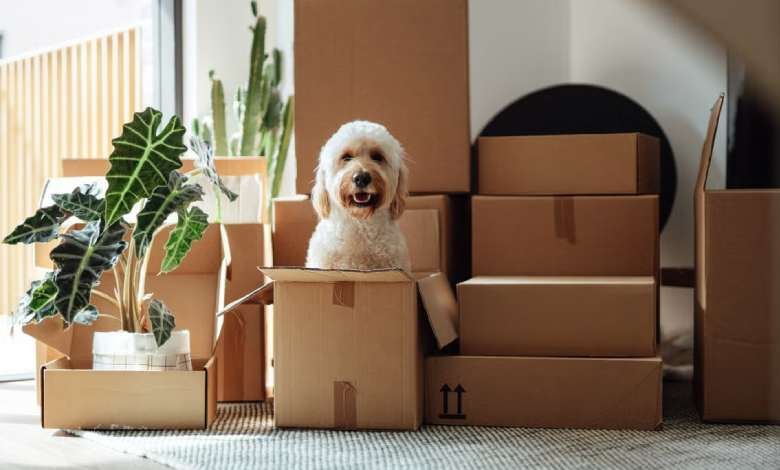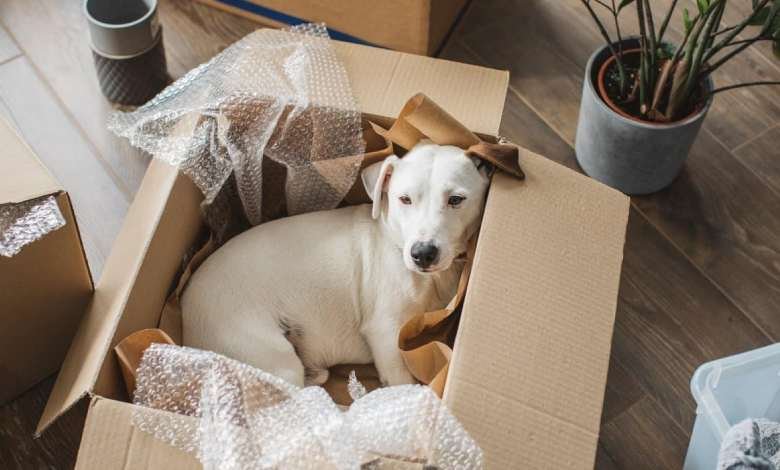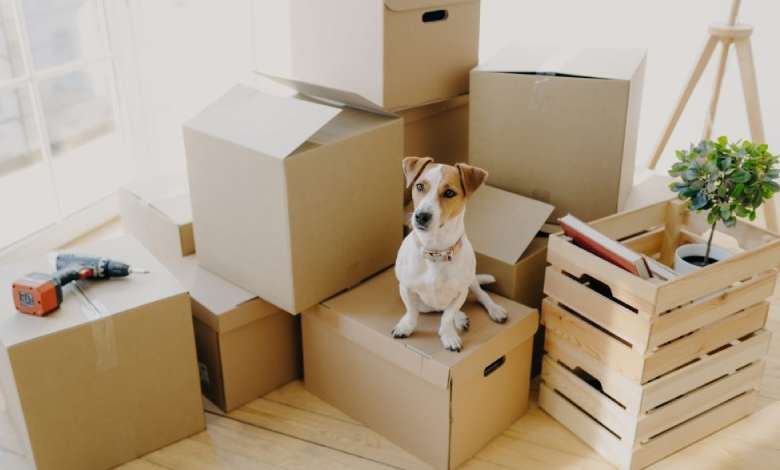For many of us, a dog isn’t just a pet; they are a cherished member of the family. They are our loyal companions, our furry confidants, and a constant source of joy. When we plan a major life change like moving to a new home—whether it’s a local move in North York or a long-distance relocation across Ontario—we naturally worry about every member of our household. And a question that weighs heavily on the minds of caring owners is: how does moving house affect your dog?
The short answer is: profoundly. Dogs are creatures of habit, routine, and territory. A move disrupts all three of these pillars of their security, often leading to stress, anxiety, and behavioural issues. They can’t understand the logic behind the sudden disappearance of furniture and the arrival of countless cardboard boxes.
But this doesn’t mean your move is destined to be a traumatic experience for your canine companion. At Top Town Movers, we believe that a successful move is one that considers the well-being of the entire family. With foresight, empathy, and a solid plan, you can make the transition to your new home a positive and exciting adventure for you and your dog. This comprehensive guide will walk you through the process, from understanding your dog’s anxiety to helping them settle in happily after the last box is unpacked.
- Learn More >>>>Tips to Make Moving Less Stressful
Section 1: Why Moving is So Stressful for Dogs
To help your dog, you first need to see the move from their perspective. Their anxiety isn’t irrational; it’s a natural response to a complete upheaval of their world. Here’s what’s going on in their mind.
1. The Upset of Routine
Dogs thrive on predictability. They know when it’s time to eat, when to expect their morning walk, and which spot on the sofa is perfect for an afternoon nap. This routine is the bedrock of their sense of security. The process of moving shatters this routine. Meals might be at odd times, walks are rushed, and you are distracted and busy. This inconsistency is the first sign to your dog that something is wrong, and it can be deeply unsettling.
2. The Loss of Territory
Your home is your dog’s kingdom. Every corner of it is mapped out in their mind, not by sight, but by scent. The familiar smells of their family, their own scent markers on the furniture, and the unique odour of the house itself tell them they are safe. A new house is an alien landscape. It smells of strangers, has unfamiliar acoustics, and lacks any of the comforting scents of their established territory. This can make them feel vulnerable and insecure.
3. The Chaos of Packing
Imagine if giant, unfamiliar objects began appearing in your home, slowly swallowing up your favourite chair, your bed, and all the things that make your space feel like your own. This is what packing looks like to a dog. The sudden appearance of boxes, the sound of packing tape, and the sight of furniture being moved or covered can be frightening. Their safe space is literally disappearing before their eyes, which can trigger significant anxiety.
4. The Reflection of Your Stress
This is perhaps the most critical factor. Dogs are emotional sponges, and they are masters at reading our body language, tone of voice, and overall energy. When you are stressed about deadlines, finances, and the endless moving checklist, your dog feels it. Your anxiety becomes their anxiety. A calm and confident owner is the most powerful tool for reassuring a nervous dog, but it’s hard to be calm when you’re overwhelmed.

- Learn More >>>>The BEST House Moving Tips (and Mistakes to Avoid)!
Section 2: Before the Move – Setting the Stage for Success
The best way to mitigate the moving house affect your dog is to plan well in advance. The weeks leading up to the move are your opportunity to prepare your dog for the coming changes.
Maintain Routine at All Costs
Even as your life becomes more chaotic, strive to keep your dog’s schedule as normal as possible.
- Walks: Keep walk times consistent. A well-exercised dog is a less anxious dog. If you have extra energy to burn, add a bit of playtime or a longer walk.
- Feeding: Feed them at the same times each day.
- Quality Time: Carve out a few minutes each day for a dedicated cuddle, a game of fetch, or a training session. This one-on-one attention reinforces your bond and provides reassurance.
Introduce Packing Materials Gradually
Don’t suddenly flood your home with boxes. A few weeks before you begin packing, bring in a few empty boxes and leave them in the living room. Let your dog sniff and explore them on their own terms. You can even toss a high-value treat or a favourite toy into a box to build a positive association. When you do start packing, try to do it one room at a time, so the disruption is more contained.
Create a “Safe Zone”
Designate one room—a spare bedroom, a den, or even a laundry room—as your dog’s sanctuary.
- Move their bed, favourite blankets, toys, and water bowl into this room.
- Try to keep this room as normal as possible for as long as possible.
- Encourage them to use this space for naps and quiet time.
- This room will be packed up last on moving day, giving them a familiar retreat from the chaos.
Update Their Information and Visit the Vet
- Vet Check-up: Schedule a visit with your veterinarian. Ensure your dog is in good health for the move and that all vaccinations are up to date. This is also the time to discuss any serious anxiety concerns. Your vet can advise on calming supplements, pheromone diffusers (like Adaptil), or prescription medication if needed.
- Microchip and ID Tags: This is absolutely critical. Update your dog’s microchip information with your new address and phone number before you move. A scared dog in a new environment is at a higher risk of getting lost. Ensure their collar has an ID tag with your mobile number clearly visible.
- Learn More >>>>500+ Things Gone | How To Declutter Like You Are Moving
Section 3: During the Move – A Plan for Moving Day
Moving day is peak chaos. The constant stream of strangers, open doors, and loud noises can be incredibly stressful for a dog. Your primary goal is to keep them safe and secure.
The Best Option: Off-Site Care
The ideal solution is to remove your dog from the situation entirely. If you have a trusted friend, family member, or a familiar doggy daycare, arrange for your dog to spend the day there. This completely shields them from the most stressful part of the process and eliminates the risk of them slipping out an open door.
If They Must Be at Home
If off-site care isn’t an option, use the “Safe Zone” you created.
- Take your dog for a long walk or a trip to the park in the morning to burn off excess energy.
- Settle them in the safe room with a frozen Kong or a puzzle toy to keep them occupied. Put a sign on the door that says, “DO NOT OPEN – DOG INSIDE.”
- Once the rest of the house is loaded onto the truck, the movers can clear out the safe room while you take your dog for another walk or wait with them in the car.
The Top Town Movers Advantage: Reducing Your Stress
This is where hiring a professional, caring moving company becomes invaluable for your pet. How moving house affect your dog is directly linked to how it affects you. By reducing your burden, we help you be the calm leader your dog needs.
- Professional Packing Service: Instead of living with weeks of clutter and chaos, our expert team can often pack your home in a day or two. This drastically shortens the period of disruption for your dog.
- Efficient and Experienced Movers: Our crews, whether for local moving or long-distance moving, work quickly and professionally. This means less time with doors propped open and strangers in your home. It frees you from the stress of managing the physical move, allowing you to focus entirely on your dog’s well-being.
- Senior Moving: We have special expertise in senior moving. We understand that for many seniors, a dog is their most important companion. Our patient, respectful, and thorough service ensures a calm environment for both owner and pet.
- Secure Storage Service: If there’s a gap between your move-out and move-in dates, our storage service provides a safe place for your belongings. This prevents the added stress of living in limbo, which your dog would certainly pick up on.

- Learn More >>>>10 Tips for Moving With Kids Without a Hitch
Section 4: After the Move – Creating a New Home
You’ve arrived! But for your dog, the journey is just beginning. The first few days and weeks are critical for helping them accept the new house as their home.
Set Up Their Space First
Before you even think about unpacking the kitchen, find a quiet corner and set up your dog’s space. Put down their familiar bed, blankets, water bowl, and a few favourite toys. This creates an immediate “home base” that smells like them and provides a sense of security in the new, strange environment.
Unpack the Old Routine Immediately
The most reassuring thing you can do is restore normalcy. Stick to your old schedule for feeding and walks as closely as possible. If 7 AM was always breakfast time, make sure it’s 7 AM in the new house. This predictability is a powerful message that even though the place is different, their life is still stable.
Supervised Exploration and “Scent Soaking”
- Leashed Tour: The first time you let your dog explore the new house and yard, keep them on a leash. Walk with them from room to room, letting them sniff everything. This prevents them from getting overwhelmed and helps you spot any potential hazards (like a loose board in the fence).
- Spread Their Scent: Here’s a great pro tip: Take one of your dog’s blankets or a towel and rub it all over them to get their scent on it. Then, walk around the house and wipe the blanket on furniture legs, doorways, and baseboards at their nose level. This “scent soaking” helps them mark the territory as their own much faster.
Be Patient with Regressions
It is common for even the most well-behaved dog to show signs of stress in a new home.
- Potty Accidents: They may have accidents inside, even if they are perfectly house-trained. This is due to stress and the unfamiliarity of their new potty spot. Go back to basics with frequent potty breaks and reward them enthusiastically for doing their business outside. Never punish them for an accident.
- Increased Barking: New sounds from neighbours or the street can trigger more barking.
- Separation Anxiety: Your dog may become more clingy or anxious when you leave. Try not to leave them alone for long periods for the first few days.
Explore the New Neighbourhood Together
Make the new neighbourhood a source of joy and fun. Start with short, calm walks, letting your dog sniff to their heart’s content—this is how they process information. Gradually explore further, discovering new parks and trails. Keep the experiences positive with treats and praise.
- Learn More >>>>top moving companies in ontario
Conclusion: You Are Your Dog’s True Home
Ultimately, the biggest factor in how moving house affect your dog is you. While they may be losing a familiar territory, they are not losing their pack leader. Your calm confidence is the anchor that will keep them steady through this sea of change.
By planning ahead, staying patient, and prioritizing their emotional needs, you can make moving a bonding experience. And by entrusting the logistical stress to a professional and compassionate company like Top Town Movers, you free yourself up to be the relaxed, reassuring presence your best friend needs. They don’t care about the new address; they just care that you are there. Together, you can make any house a home

































